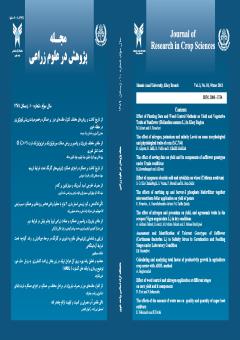-
-
List of Articles
-
Open Access Article
1 - Effect of Planting Date and Weed Control Methods on Yield and Vegetative Traits of Sunflower (Helianthus annuus L.) in Khoy Region
مجتبي اكبري sasan rezadust -
Open Access Article
2 - The effect of nitrogen, potassium and salinity Levels on some morphological and physiological traits of corn (S.C.704)
-
Open Access Article
3 - The effect of sowing date on yield and its components of safflower genotypes under Urmia climatic conditions
علیرضا عیوضی -
Open Access Article
4 - Effect of exogenous abscisic acid and cytokinin on wheat (Triticum aestivum)
سیف الله کیا چهارباغي -
Open Access Article
5 - The effects of earthing up and barvar-2 phosphate biofertilizer together with micronutrients foliar application on yield of potato
النا عیوضلو -
Open Access Article
6 - The effect of nitrogen and potassium on yield, and agronomic traits of cowpea (Vigna unguiculata L.) in dry conditions
علي عبدزاد گوهري -
Open Access Article
7 - Assessment and Identification of Tolerant Genotypes of Safflower (Carthamus tinctorius L.) to Salinity Stress in Germination and Seedling Stages under Laboratory Condition
Khodadad Mostafavi -
Open Access Article
8 - Calculating and analyzing total factor of productivity growth in agriculture crop sector with ARDL method
علي باقرزاده -
Open Access Article
9 - Effect of weed control and nitrogen application at different stages on corn yield and it components
ندا فوزي -
Open Access Article
10 - The effects of the amount of water usage on quality and quantity of sugar beet cultivars
اسماعیل نبی زاده
-
The rights to this website are owned by the Raimag Press Management System.
Copyright © 2021-2025







